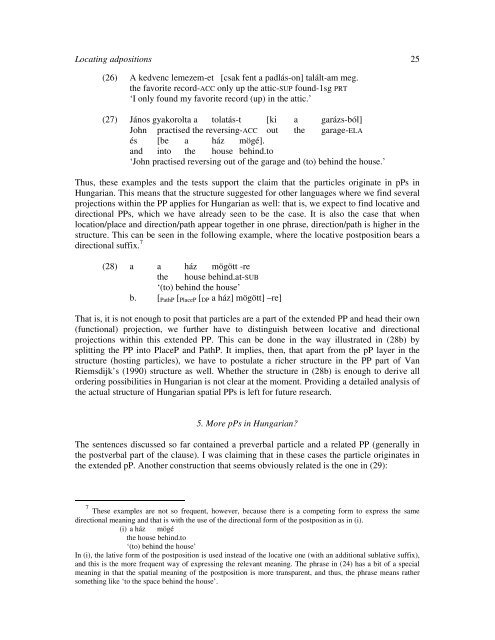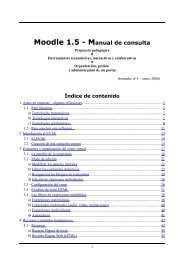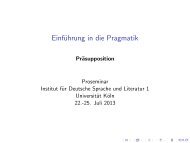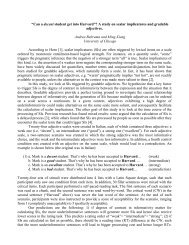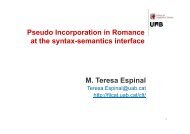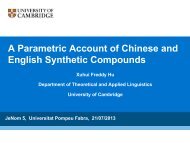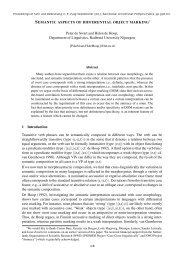Locating adpositions. - corpora@parles.upf
Locating adpositions. - corpora@parles.upf
Locating adpositions. - corpora@parles.upf
You also want an ePaper? Increase the reach of your titles
YUMPU automatically turns print PDFs into web optimized ePapers that Google loves.
<strong>Locating</strong> <strong>adpositions</strong> 25<br />
(26) A kedvenc lemezem-et [csak fent a padlás-on] talált-am meg.<br />
the favorite record-ACC only up the attic-SUP found-1sg PRT<br />
‘I only found my favorite record (up) in the attic.’<br />
(27) János gyakorolta a tolatás-t [ki a garázs-ból]<br />
John practised the reversing-ACC out the garage-ELA<br />
és [be a ház mögé].<br />
and into the house behind.to<br />
‘John practised reversing out of the garage and (to) behind the house.’<br />
Thus, these examples and the tests support the claim that the particles originate in pPs in<br />
Hungarian. This means that the structure suggested for other languages where we find several<br />
projections within the PP applies for Hungarian as well: that is, we expect to find locative and<br />
directional PPs, which we have already seen to be the case. It is also the case that when<br />
location/place and direction/path appear together in one phrase, direction/path is higher in the<br />
structure. This can be seen in the following example, where the locative postposition bears a<br />
directional suffix. 7<br />
(28) a a ház mögött -re<br />
the house behind.at-SUB<br />
‘(to) behind the house’<br />
b. [ PathP [ PlaceP [ DP a ház] mögött] –re]<br />
That is, it is not enough to posit that particles are a part of the extended PP and head their own<br />
(functional) projection, we further have to distinguish between locative and directional<br />
projections within this extended PP. This can be done in the way illustrated in (28b) by<br />
splitting the PP into PlaceP and PathP. It implies, then, that apart from the pP layer in the<br />
structure (hosting particles), we have to postulate a richer structure in the PP part of Van<br />
Riemsdijk’s (1990) structure as well. Whether the structure in (28b) is enough to derive all<br />
ordering possibilities in Hungarian is not clear at the moment. Providing a detailed analysis of<br />
the actual structure of Hungarian spatial PPs is left for future research.<br />
5. More pPs in Hungarian?<br />
The sentences discussed so far contained a preverbal particle and a related PP (generally in<br />
the postverbal part of the clause). I was claiming that in these cases the particle originates in<br />
the extended pP. Another construction that seems obviously related is the one in (29):<br />
7 These examples are not so frequent, however, because there is a competing form to express the same<br />
directional meaning and that is with the use of the directional form of the postposition as in (i).<br />
(i) a ház mögé<br />
the house behind.to<br />
‘(to) behind the house’<br />
In (i), the lative form of the postposition is used instead of the locative one (with an additional sublative suffix),<br />
and this is the more frequent way of expressing the relevant meaning. The phrase in (24) has a bit of a special<br />
meaning in that the spatial meaning of the postposition is more transparent, and thus, the phrase means rather<br />
something like ‘to the space behind the house’.


